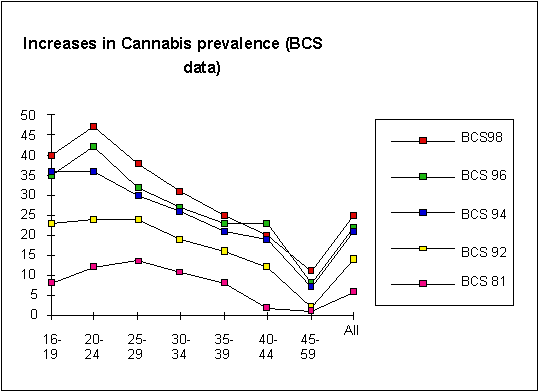Home Office Survey finds half of young people
tried drugs.
Results from
the 1998 British Crime Survey shows further increases
in levels of drug use compared to previous years.
Half (49%)
of young people aged 16-29 had tried one or more illegal
drugs, with cannabis by far the most frequently used
drug (42% of younger respondents 16-29, 25% of all respondents).
One in seven illicit drug users (7% of total) reported
never having used cannabis, but having used other drugs.
Next in line were amphetamines (20%/10%), Poppers (16%/7%),
LSD (11%/5%), mushrooms (10%/5%) and ecstasy (10%/4%).
Although media reports indicated a large surge in the
use of cocaine, lifetime use among young people was
only 6%, or 3% for all adults of working age. Use of
heroin or crack cocaine were very low, with around 1%
of young people and slightly less of all adults admitting
ever having tried heroin, crack or methadone.
When compared
with results from previous years, the steady increase
in use at all age levels becomes apparent, with record
numbers of over 45"s having tried drugs. Although
this partly represents a generational change, as those
who have ever tried drugs progress through the age ranges,
however, there was a a 50% increase in lifetime cannabis
prevalence for the 40-44 age group in 1998 (20%), compared
to the equivalent 25-29 age group in 1981 (13.5%). Furthermore,
this figure appeared somewhat lower than would be expected,
probably a statistical abberation, as the equivalent
35-40 age cohort in 1994 reported higher prevalence
(21%). As this was not a longitudinal study, there will
always be random variations in reported figures.

The figures
most comparable with those from our regular users surveys
would be the "used in past month" statistics.
Fourteen percent of young people admitted cannabis use
in the past month, or 5% of the total (7% of men, 4%
of women). Given the results from our own surveys, the
majority of past month users are likely to be daily
users of cannabis. The young peoples "recent use"
figure also is similar to the incidence of positive
cannabis tests in road accident victims.
It is important
to note that these levels of drug use were admitted
by respondents using a lap-top computer provided by
research staff, but otherwise identifiable in theory,
subject to assurances of confidentiality. The not-absolutely-anonymous
nature of the survey is thus likely to have deterred
individuals from giving entirely truthful answers, so
results are more likely to underestimate than overestimate
prevalence and levels of recent or current use. Furthermore,
in a "household" survey, individuals who were
not at home when the researchers visited (e.g. out partying)
or of no fixed abode (travellers/homeless), also more
likely to have used drugs, would be underrepresented.
The study
gives a wealth of information about drug users, including
demographic data showing drug use to be highest in either
affluent areas or depressed areas, and highest of all
among unemployed inhabitants of otherwise prosperous
areas. Unfortunately, although a large sample is used,
respondents were not asked more detailed questions about
frequency of use and the costs involved, or indeed prices
of drugs.
IDMU has
suggested further analyses within the "used cannabis/any
drug in past month" group to compare prevalence
and frequency of use with our own data.
The results
are downloadable online in pdf (Acrobat) format from
the Home Office Research Development & Statistics
Directorate (RDS) website at (click on their publications
link if list does not appear). Hard copies can also
be ordered from the site via email (save your printer/eyesight):
http://www.homeoffice.gov.uk/rds/wnewf.htm
A brief summary
of results - Drug Misuse Declared in 1998... - is provided
in a 4-page Research Findings paper RF93
The full
document (110pp) is a Home Office Research Studies section
paper HORS197
The RDS publications
page is thoroughly recommended as a source of downloadable
research studies covering many aspects of drug use,
crime and penal policy.